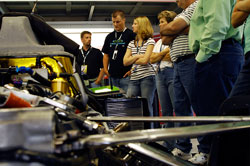 The man that built The Ethanol Promotion and Information Council from the ground up is Board President Tom Branhan, CEO and general manager of Glacial Lakes Energy. When I caught up with him on the bus, he said the transition to 100 percent ethanol fuel in the Indy Racing League is a major stride for the ethanol industry, and he said there’s certainly more opportunity to keep up that pace. Tom pointed out that every IndyCar runs strictly on Honda motors, but as the ethanol industry expands to other major motor series, that means a larger variety of engines that will be built to run on ethanol.
The man that built The Ethanol Promotion and Information Council from the ground up is Board President Tom Branhan, CEO and general manager of Glacial Lakes Energy. When I caught up with him on the bus, he said the transition to 100 percent ethanol fuel in the Indy Racing League is a major stride for the ethanol industry, and he said there’s certainly more opportunity to keep up that pace. Tom pointed out that every IndyCar runs strictly on Honda motors, but as the ethanol industry expands to other major motor series, that means a larger variety of engines that will be built to run on ethanol.
Tom said this year’s Honda motors built specifically for ethanol fuel are running farther and faster on the same amount of fuel than methanol – the fuel the IRL series used previously. He said ethanol’s performance shows that it can be run in just about any engine if it’s set up for it, getting better mileage and better horsepower. Tom says he’s confident the 91st Indy 500 race will also demonstrate that use of ethanol also amounts to less wear and tear on the IndyCars.
Tom pointed out that as more engines are designed for use of ethanol fuel, EPIC’s role in educating the public will be increasingly vital.
[audio:http://www.zimmcomm.biz/epic/branhan-tom2.mp3]

 Amidst the hustle and bustle of race weekend events, I caught up with
Amidst the hustle and bustle of race weekend events, I caught up with  The big story here in Indianapolis this morning has been the weather. It’s lightly raining now and the trucks are running the track to try to keep as much water off it as possible. You can’t race on a wet track.
The big story here in Indianapolis this morning has been the weather. It’s lightly raining now and the trucks are running the track to try to keep as much water off it as possible. You can’t race on a wet track. The keynote speaker at the EPIC reception was IndyCar driver Jeff Simmons. Jeff was in great spirits on the eve of the big race here in Indy. I’ve got the audio from his remarks to the group last night.
The keynote speaker at the EPIC reception was IndyCar driver Jeff Simmons. Jeff was in great spirits on the eve of the big race here in Indy. I’ve got the audio from his remarks to the group last night. One of the inventions of the Ethanol Promotion and Information Council is the “e”-tini, a very colorful martini. Actually there are 3 different ones and I’ll have to update this post to provide the details on them.
One of the inventions of the Ethanol Promotion and Information Council is the “e”-tini, a very colorful martini. Actually there are 3 different ones and I’ll have to update this post to provide the details on them. I think it shows that you’ve “arrived” when you can have an ice sculpture at your reception. This one greeted us at the EPIC pre-race reception where members gathered to hear from a number of organizational representatives.
I think it shows that you’ve “arrived” when you can have an ice sculpture at your reception. This one greeted us at the EPIC pre-race reception where members gathered to hear from a number of organizational representatives. The theme for this year’s 50th IPL Festival Parade in downtown Indianapolis was “Spirit and Speed.” There certainly was a lot of spirit from the crowd as celebrity after celebrity filed by on classic cars and Indy-related floats. The parade showcased each of the 33 competitors for the Indy 500 race Sunday along with more than a dozen other high-profile stars and groups. EPIC members slid into a top notch spot for catching more than a glimpse of all the stars. NFL quarterback Peyton Manning served as the parade’s Grand Marshal.
The theme for this year’s 50th IPL Festival Parade in downtown Indianapolis was “Spirit and Speed.” There certainly was a lot of spirit from the crowd as celebrity after celebrity filed by on classic cars and Indy-related floats. The parade showcased each of the 33 competitors for the Indy 500 race Sunday along with more than a dozen other high-profile stars and groups. EPIC members slid into a top notch spot for catching more than a glimpse of all the stars. NFL quarterback Peyton Manning served as the parade’s Grand Marshal.  Members also spotted Ludacris, John Oats, Gene Simmons, Grey’s Anatomy stars Patrick Dempsey and Eric Dane among others. Dempsey is slated to drive the pace car during the Indy 500 race. The crowds cheered as U.S. military officers filed by in uniform. American Hero General Chuck Yeager received a warm welcome from spectators. Olympian gold medalists and top models were also showcased in the collection of celebrities who were eager to greet the public.
Members also spotted Ludacris, John Oats, Gene Simmons, Grey’s Anatomy stars Patrick Dempsey and Eric Dane among others. Dempsey is slated to drive the pace car during the Indy 500 race. The crowds cheered as U.S. military officers filed by in uniform. American Hero General Chuck Yeager received a warm welcome from spectators. Olympian gold medalists and top models were also showcased in the collection of celebrities who were eager to greet the public. Enough with the replicas. This time it was the real deal for EPIC Members. The ethanol team handed out all-access passes for a peek into what makes an IndyCar run at more than 230 miles an hour. Letterman-Rahal Racing’s Steve Shunck led members on a tour through the garages for Rahal-Letterman IndyCar Drivers Jeff Simmons and Scott Sharp. From the shiny brass engine to the $10,000 steering wheel, members got a close-up look at the gears, nuts and bolts of Ethanol’s #17 IndyCar and Petron’s #8 IndyCar. For those of you that missed out on this rare inside look, don’t fret. All of Steve’s nitty gritty information was caught on tape:
Enough with the replicas. This time it was the real deal for EPIC Members. The ethanol team handed out all-access passes for a peek into what makes an IndyCar run at more than 230 miles an hour. Letterman-Rahal Racing’s Steve Shunck led members on a tour through the garages for Rahal-Letterman IndyCar Drivers Jeff Simmons and Scott Sharp. From the shiny brass engine to the $10,000 steering wheel, members got a close-up look at the gears, nuts and bolts of Ethanol’s #17 IndyCar and Petron’s #8 IndyCar. For those of you that missed out on this rare inside look, don’t fret. All of Steve’s nitty gritty information was caught on tape: It’s the day before the 91st running of the Indianapolis 500 and things are relatively quiet at the track. However, I’m sure there’s lots of activity in this garage making last minute tweaks on the car.
It’s the day before the 91st running of the Indianapolis 500 and things are relatively quiet at the track. However, I’m sure there’s lots of activity in this garage making last minute tweaks on the car. One of the
One of the